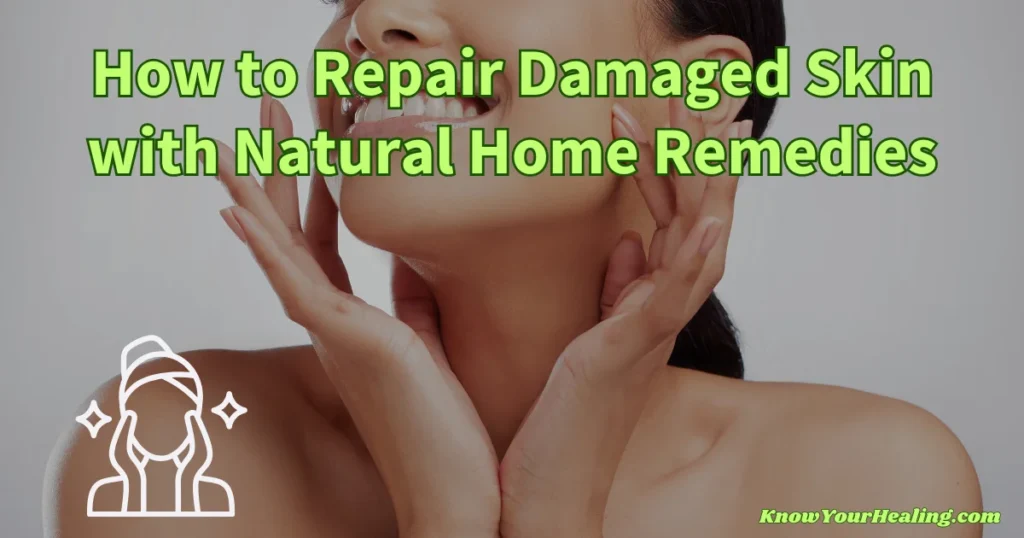How to repair damaged skin home remedies is a concern for many seeking healthier, glowing skin.
Many struggle with skin damage caused by the sun, pollution, or other factors, and these effective methods promise a solution.
Harnessing the power of ingredients like aloe vera and turmeric can dramatically improve skin health.
You will discover tips and practices to restore your skin’s vitality naturally.
Hydrating and incorporating antioxidants are essential steps anyone can follow at home.
This article will guide you through simple yet powerful home remedies to achieve clear and smooth skin.
Understanding Skin Damage and Its Causes
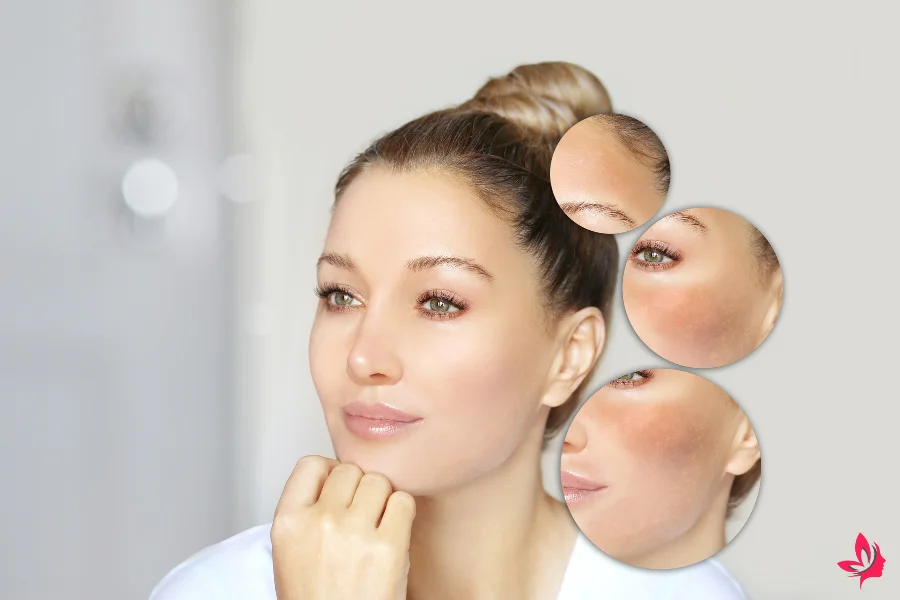
Skin damage can result from various factors, and understanding these causes is crucial for effective prevention and treatment.
Environmental exposure, lifestyle choices, and personal habits all affect the state of one’s skin.
What Causes Skin Damage?
Sun exposure is a leading cause of skin damage. UV rays penetrate the skin, causing sun-damaged skin and issues like brown spots or fine lines. Using sunscreen daily is an effective preventative measure.
Pollution and environmental chemicals contribute to skin damage by generating free radicals, which harm skin cells. These can accelerate aging and lead to uneven skin texture.
Antioxidant-rich foods, such as those high in vitamin C, can help combat this damage.
Lifestyle factors, like smoking and poor diet, also damage the skin, affecting collagen production and leading to premature aging.
Adopting a healthy lifestyle and using natural ingredients like coconut oil and aloe vera can aid repair and maintenance.
Identifying Different Types of Skin Damage
Different skin types respond differently to damage.
Sun-damaged skin often presents as brown spots, rough patches, and age spots.
People with acne-prone skin may experience dark spots and scars, often requiring specific skincare routines.
Irritation from harsh skincare products can cause reactions, especially in sensitive skin.
Choosing the right products that match one’s skin type is crucial.
For dry skin, ingredients like hyaluronic acid and shea butter are helpful.
Early signs of sun exposure or pollutant damage might also show fine lines or uneven skin tone.
Identifying these signs early allows for incorporating natural remedies and antioxidants into the daily skincare routine, helping prevent further damage.
Natural Ingredients to Repair Damaged Skin
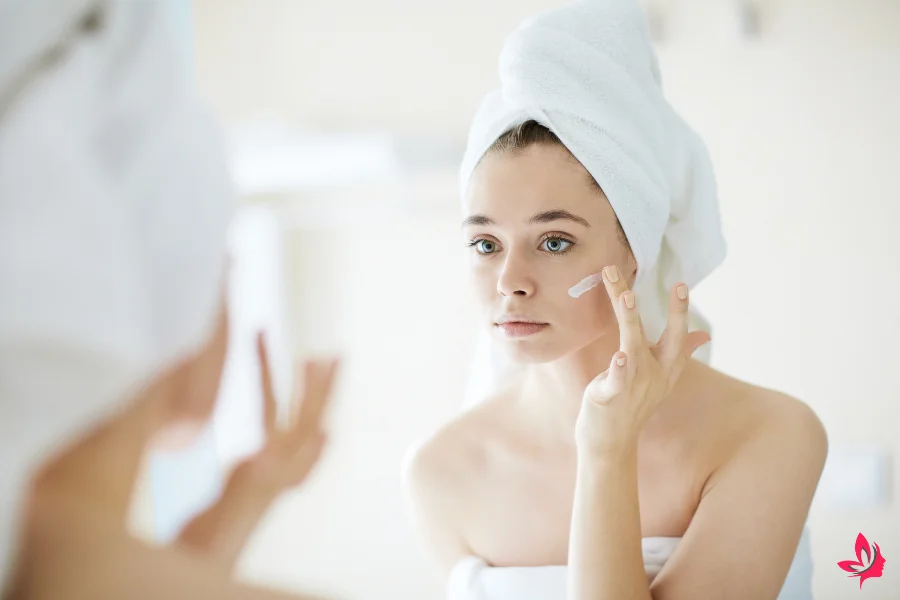
Repairing damaged skin naturally involves using ingredients that can improve skin texture, reduce signs of aging, and soothe irritation.
Incorporating antioxidants, moisturizers, and other nourishing components into a skincare routine can enhance results and support various skin types.
Benefits of Vitamin C and Vitamin E
Vitamin C is renowned for brightening the skin, reducing dark spots, and enhancing collagen production.
This vitamin is critical in repairing sun-damaged skin, as it combats free radicals that accelerate aging.
Using vitamin C serums can significantly improve skin tone and even reduce the appearance of fine lines.
Vitamin E works alongside vitamin C to protect the skin barrier.
It has moisturizing properties that soothe dry skin and provide much-needed hydration.
This vitamin can help repair sun-damaged skin and is often found in natural skincare products like creams and lotions.
Using Aloe Vera and Coconut Oil
Aloe vera is well-known for its soothing effects on skin irritation and inflammation.
It relieves sun-damaged skin and is an effective moisturizer for all skin types.
Rich in antioxidants, aloe vera can also promote healing and help repair minor skin damage.
Coconut oil is another natural ingredient highly praised for its ability to hydrate and nourish the skin.
Rich in fatty acids, it helps maintain the integrity of the skin barrier and can help repair dry skin by locking in moisture.
It’s a versatile option for those looking to include more natural oils in their skincare routine.
Essential Oils and Herbal Teas
Essential oils, including lavender and tea tree oil, can help repair damaged skin by reducing inflammation and preventing bacterial infections.
These oils often address specific skin conditions due to their healing properties.
Herbal teas like green tea are rich in antioxidants that protect against UV radiation and aid in repairing skin damage.
Drinking these teas or using them in skincare formulations can support healthier skin.
They work well alongside other natural remedies to mitigate uneven skin texture and promote overall health.
DIY Home Remedies for Skin Repair
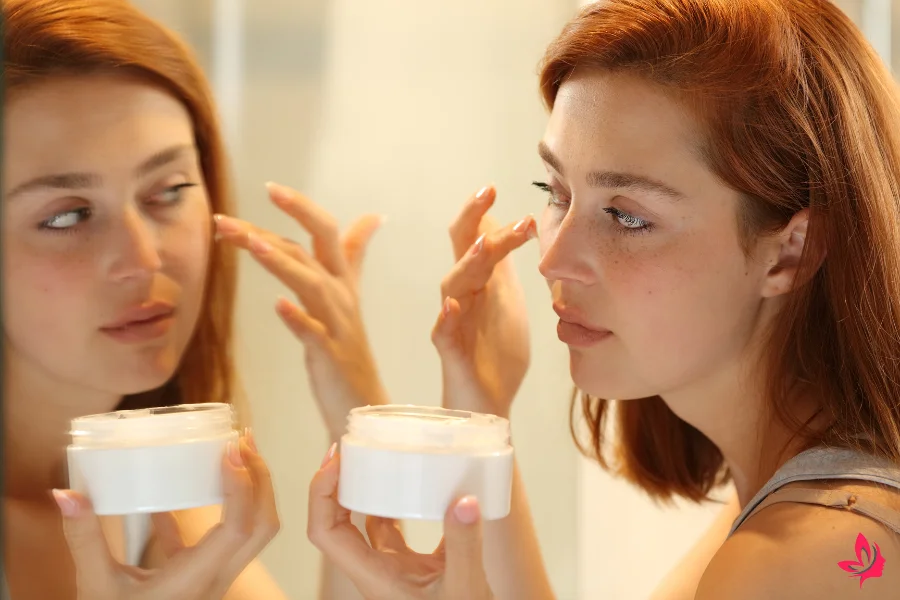
Repairing damaged skin at home involves incorporating natural ingredients and simple practices into a routine. This approach can effectively address issues like dryness, irritation, and sun damage.
Creating a Natural Skincare Routine
Developing a natural skincare routine tailored to one’s skin type is essential.
Incorporating vitamin C serums can enhance collagen production, address fine lines, and improve skin tone.
Many find that aloe vera gel is soothing after sun exposure, helping to heal sun-damaged skin and reduce redness.
Natural oils like coconut or olive oil are excellent for hydration.
They contain essential fatty acids that nourish and repair the skin barrier.
Double cleansing with gentle, natural skincare products removes impurities without stripping the skin of its natural oils.
Remedies for Specific Skin Conditions
Addressing specific skin conditions requires targeted treatment.
Shea butter can provide deep moisturization for dry or sensitive skin. Its rich texture helps combat flaky skin and restore the damaged barrier.
Those with dark spots may benefit from exfoliating and brightening their skin with glycolic acid or other alpha hydroxy acids.
Acne-prone individuals should be cautious of products causing allergic reactions or irritation.
Incorporating tea tree oil—known for its antibacterial properties—may reduce acne breakouts and skin irritation.
Natural remedies like honey or oatmeal masks can soothe inflamed areas and help with redness reduction.
Using Common Household Items
Household items are often practical for gentle skin repair.
Petroleum jelly is widely used to treat cracked, dry skin, while baking soda is a mild exfoliant that helps to even out skin texture.
Herbal teas, particularly chamomile, are beneficial for soothing itchy or irritated skin due to their anti-inflammatory properties.
Many use cucumbers to reduce puffiness and dark circles, leveraging their hydrating effects.
For those with sun spots or age spots, a light lemon juice application might lighten these areas over time, though sun protection is crucial to prevent further damage from UV rays.
Professional Treatments and In-Office Procedures
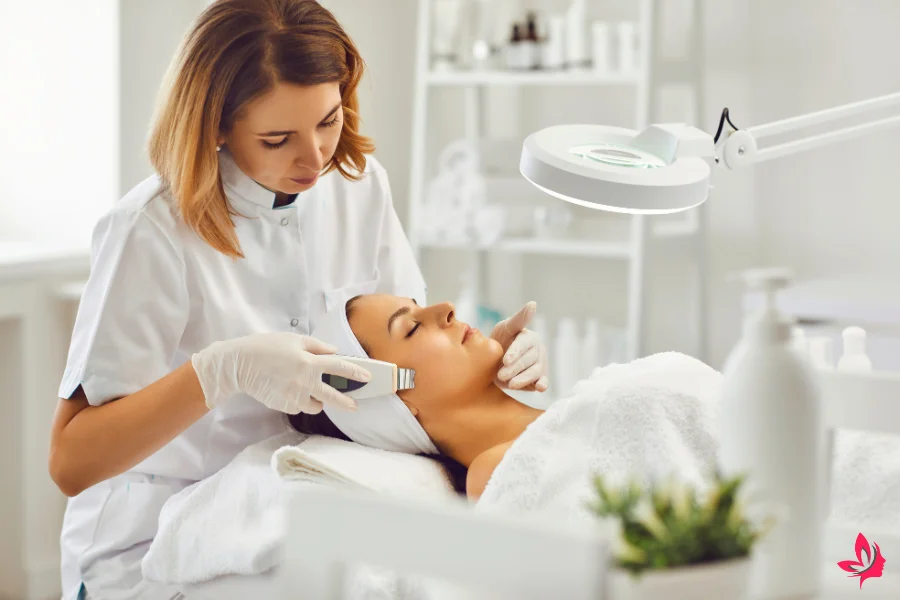
Repairing damaged skin often requires professional treatments that offer targeted solutions.
Chemical peels and steroid creams can rejuvenate the skin and address specific issues such as acne scars, sun damage, and uneven texture, enhancing its health and appearance.
Chemical Peels and Their Benefits
Chemical peels are an effective method to reduce fine lines and remove brown spots caused by sun exposure.
This treatment involves applying a solution containing active ingredients, such as glycolic acid or alpha hydroxy acid, to exfoliate the skin.
Chemical peels help improve skin texture and tone by removing the outer layer.
For individuals with acne-prone skin, chemical peels can lessen acne scars and improve overall skin condition.
They can be customized based on skin type to achieve the best results.
Light peels offer a gentle exfoliation, while deeper peels target more severe damage.
When performed by professionals, such procedures often enhance collagen production and provide long-term benefits.
Steroid Creams and Other Treatments
Steroid creams are commonly prescribed for specific skin issues, relieving skin irritation and allergic reactions.
These creams can reduce inflammation and promote healing in dry, flaky skin or sensitive areas.
As a complement to a daily skincare routine, steroid creams may help maintain a strong skin barrier.
Beyond steroid creams, other in-office treatments like laser therapy and microdermabrasion are available.
These procedures address various skin conditions and enhance healing by increasing blood flow and collagen production.
Under professional guidance, these treatments can enhance the effectiveness of natural skincare products and improve the skin’s resilience against UV rays and free radicals.
Preventing Future Skin Damage

Preventive measures can significantly reduce the risk of skin damage.
People can maintain smoother and healthier skin by protecting it from harmful UV rays, using the right skincare products, and incorporating healthy lifestyle habits.
Let’s explore key strategies to achieve this.
Sun Protection and UV Exposure
Sun protection is crucial for preventing skin damage.
Regular use of broad-spectrum sunscreen helps shield skin from UV rays, preventing sun damage and reducing the risk of brown spots and fine lines.
Protective clothing such as wide-brimmed hats and sunglasses protects against harmful rays.
People with sensitive skin should use gentle, mineral-based sunscreens to avoid irritation.
Reapplying sunscreen every two hours, especially after swimming or sweating, ensures consistent protection.
Utilizing multiple layers of defense against UV exposure is essential for keeping skin healthy and youthful.
Maintaining Healthy Skin with the Right Products
The right products tailored to specific skin types are vital in maintaining skin health.
A daily moisturizer that contains vitamins and antioxidants can support skin barrier function and mitigate the effects of free radicals.
Incorporating serums with vitamin C promotes collagen production and improves skin tone.
Natural oils, like coconut or olive oil, nourish and hydrate dry skin, helping to repair damaged areas.
To avoid allergic reactions, people should follow a skincare routine that cleanses, moisturizes, and protects skin without using harsh chemicals.
Choosing natural skincare products can reduce sensitivity and promote healing.
Lifestyle Changes for Better Skin Health
Lifestyle habits greatly influence skin condition.
Staying hydrated supports the skin’s natural barrier and aids in repairing damage.
Incorporating antioxidant-rich foods into the diet benefits the skin by neutralizing free radicals and reducing oxidative stress.
Regular exercise facilitates better blood circulation, which nourishes skin cells.
Avoiding smoking and limiting alcohol intake can prevent the early signs of aging and improve overall skin quality.
Like green tea, herbal teas provide antioxidants that further support skin health.
Healthy habits are the best way to keep skin in optimal condition and fortify it against future damage.
Final Thoughts
Repairing damaged skin with home remedies can be a practical approach for many.
Individuals need to focus on gentle, natural ingredients that support skin healing.
Aloe vera is popular due to its soothing properties, while coconut oil is an excellent moisturizer.
Home remedies often involve ingredients like shea butter, which, thanks to its regenerative effects, is known to reduce scar tissue.
Green tea extract and vitamin C are also beneficial for revitalizing skin due to their antioxidant properties.
Regular use of these natural solutions can aid in repairing the skin barrier.
Pair these remedies with daily habits such as staying hydrated and protecting the skin from sun exposure.
Key Takeaways:
- Use pure aloe vera gel to soothe and heal the skin.
- Incorporate natural elements like green tea extract and vitamin C for added antioxidants.
- Moisturize regularly with coconut oil or shea butter.
- Practice good skincare habits, including sun protection and gentle cleansing.
Frequently Asked Questions
Treating damaged skin naturally involves using ingredients like aloe vera and moisturizing oils.
Protecting the skin barrier by using gentle products, staying hydrated, and avoiding harsh chemicals is important.
How do you heal skin damage fast?
Healing skin damage quickly can involve using pure aloe vera gel and moisturizing regularly to keep the skin hydrated.
Avoiding sun exposure and using sunscreen is crucial.
Can damaged skin be restored?
Yes, damaged skin can often be restored with consistent care.
Use products containing antioxidants that promote healing and repair.
Regular application of moisturizers rich in ceramides helps in strengthening the skin barrier.
What is the fastest way to heal a damaged skin barrier?
A damaged skin barrier can be healed using moisturizers containing ceramides or hyaluronic acid.
Products with petrolatum can also seal in moisture, aiding in faster recovery.
How can I help my skin repair itself?
The skin can repair itself by staying hydrated, consuming a balanced vitamin-rich diet, and using gentle skincare products.
Rosewater may soothe redness and balance skin pH.
How do you speed up skin healing?
Speed up skin healing by keeping the area moisturized and free from irritants.
Natural remedies like shea butter provide essential nourishment.
Also, avoid touching or picking at the skin to prevent further damage.
Does Vaseline repair skin barriers?
Yes, Vaseline can assist in repairing skin barriers.
It acts as an occlusive agent that locks in moisture, supporting natural healing.
How can you repair a skin barrier naturally overnight?
To repair a skin barrier naturally overnight, apply a rich moisturizer with ceramides and facial oil to seal in moisture.
Avoid harsh cleansers that strip the skin of natural oils.
What ointment is good for broken skin?
For broken skin, ointments containing petrolatum or zinc oxide are effective.
They provide a protective layer, reducing infection risk while keeping the skin hydrated.
Can aloe vera repair damaged skin?
Aloe vera is excellent for repairing damaged skin. It offers soothing, anti-inflammatory properties and hydrates the skin, making it a practical part of any natural skincare routine.
What oil is good for skin barrier repair?
Facial oils like rosehip or coconut oil are beneficial for repairing the skin barrier.
They provide fatty acids that nourish and protect the skin. This promotes natural repair processes.

